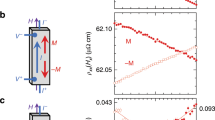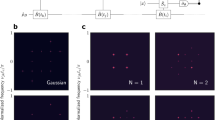Abstract
The hallmark of materials science is the ability to tailor the microstructure of a given material to provide a desired response. Carbon mixed with iron provides the steel of buildings and bridges; impurities sprinkled in silicon single crystals form the raw materials of the electronics revolution; pinning centres in superconductors let them become powerful magnets. Here, we show that either adding a few parts per million of the proper chemical impurities to indium antimonide, a well-known semiconductor, or redesigning the material’s structure on the micrometre scale, can transform its response to an applied magnetic field. The former approach is purely quantum mechanical1,2,3; the latter a classical outgrowth of disorder4,5,6,7, turned to advantage. In both cases, the magnetoresistive response—at the heart of magnetic sensor technology—can be converted to a simple, large and linear function of field that does not saturate. Harnessing the effects of disorder has the further advantage of extending the useful applications range of such a magnetic sensor to very high temperatures by circumventing the usual limitations imposed by phonon scattering.
This is a preview of subscription content, access via your institution
Access options
Subscribe to this journal
Receive 12 print issues and online access
$259.00 per year
only $21.58 per issue
Buy this article
- Purchase on Springer Link
- Instant access to full article PDF
Prices may be subject to local taxes which are calculated during checkout



Similar content being viewed by others
References
Abrikosov, A. A. Galvanomagnetic phenomena in metals in the quantum limit. Sov. Phys.—JETP 29, 746–753 (1969).
Abrikosov, A. A. Quantum magnetoresistance. Phys. Rev. B 58, 2788–2794 (1998).
Abrikosov, A. A. Quantum linear magnetoresistance. Europhys. Lett. 49, 789–793 (2000).
Parish, M. M. & Littlewood, P. B. Non-saturating magnetoresistance in heavily disordered semiconductors. Nature 426, 162–165 (2003).
Parish, M. M. & Littlewood, P. B. Classical magnetotransport of inhomogeneous conductors. Phys. Rev. B 72, 094417 (2005).
Hu, J. S., Rosenbaum, T. F. & Betts, J. B. Current jets, disorder, and linear magnetoresistance in the silver chalcogenides. Phys. Rev. Lett. 95, 186603 (2005).
Hu, J. S., Parish, M. M. & Rosenbaum, T. F. Nonsaturating magnetoresistance of inhomogeneous conductors: Comparison of experiment and simulation. Phys. Rev. B 75, 214203 (2007).
Olsen, J. L. Electron Transport in Metals (Interscience, New York, 1962).
Binasch, G., Grünberg, P., Saurenbach, F. & Zinn, W. Enhanced magnetoresistance in layered magnetic structures with antiferromagnetic interlayer exchange. Phys. Rev. B 39, 4828–4830 (1989).
Baibich, M. N. et al. Giant magnetoresistance of (001)Fe/(001)Cr magnetic superlattices. Phys. Rev. Lett. 61, 2472–2475 (1988).
von Helmolt, R., Wecker, J., Holzapfel, B., Schultz, L. & Samwer, K. Giant negative magnetoresistance in perovskitelike La2/3Ba1/3MnOx ferromagnetic films. Phys. Rev. Lett. 71, 2331–2333 (1993).
von Molnar, S., Briggs, A., Flouquet, J. & Remenyi, G. Electron localization in a magnetic semiconductor Gd3−xvxS4 . Phys. Rev. Lett. 51, 706–709 (1983).
Solin, S. A. et al. Enhanced room-temperature geometric magnetoresistance in inhomogeneous narrow-gap semiconductors. Science 289, 1530–1532 (2000).
Herring, C. Effect of random inhomogeneities on electrical and galvanomagnetic measurements. J. Appl. Phys. 31, 1939–1953 (1960).
Kapitza, P. L. The study of the specific resistance of bismuth crystals and its change in strong magnetic fields and some allied problems. Proc. R. Soc. London A 119, 358–443 (1928).
Yang, F. Y. et al. Large magnetoresistance of electrodeposited single-crystal bismuth thin films. Science 284, 1335–1337 (1999).
Breckenridge, R. G. et al. Electrical and optical properties of intermetallic compounds I. Indium antimonide. Phys. Rev. 96, 571–575 (1954).
Heremans, J. Solid-state magnetic field sensors and applications. J. Phys. D 26, 1149–1168 (1993).
Hrostowski, H. J., Morin, F. J., Geballe, T. H. & Wheatley, G. H. Hall effect and conductivity of InSb. Phys. Rev. 100, 1672–1676 (1955).
Madelung, O. Physics of III–V Compounds (Wiley, New York, 1964).
Fritzsche, H. & Lark-Horovitz, K. Electrical properties of p-type indium antimonide at low temperatures. Phys. Rev. 99, 400–405 (1955).
Frederikse, H. P. R. & Hosler, W. R. Galvanomagnetic effects in n-type indium antimonide. Phys. Rev. 108, 1136–1145 (1957).
Xu, R. et al. Large magnetoresistance in non-magnetic silver chalcogenides. Nature 390, 57–60 (1997).
Ogorelec, Z., Hamzic, A. & Basletic, M. On the optimization of the large magnetoresistance of Ag2Se. Europhys. Lett. 46, 56–61 (1999).
Husmann, A. et al. MegaGauss sensors. Nature 417, 421–424 (2002).
Lee, M., Rosenbaum, T. F., Saboungi, M.-L. & Schnyders, H. S. Band-gap tuning and linear magnetoresistance in silver chalcogenides. Phys. Rev. Lett. 88, 066602 (2002).
Novoselov, K. S. et al. Electric field effect in atomically thin carbon films. Science 306, 666–669 (2004).
Novoselov, K. S. et al. Two-dimensional gas of massless Dirac fermions in graphene. Nature 438, 197–200 (2005).
Cheianov, V. V. et al. Random resistor network model of minimal conductivity in graphene. Phys. Rev. Lett. 99, 176801 (2007).
Cheianov, V. V., Fal‘ko, V. & Altshuler, B. L. The focusing of electron flow and a Veselago lens in graphene. Science 315, 1252–1255 (2007).
Acknowledgements
The authors thank M. M. Parish for valuable discussions on the Parish–Littlewood model. The work at the University of Chicago was supported by DOE Basic Energy Sciences.
Author information
Authors and Affiliations
Contributions
J.H. and T.F.R. contributed equally to all parts of the project.
Corresponding author
Rights and permissions
About this article
Cite this article
Hu, J., Rosenbaum, T. Classical and quantum routes to linear magnetoresistance. Nature Mater 7, 697–700 (2008). https://doi.org/10.1038/nmat2259
Issue Date:
DOI: https://doi.org/10.1038/nmat2259



